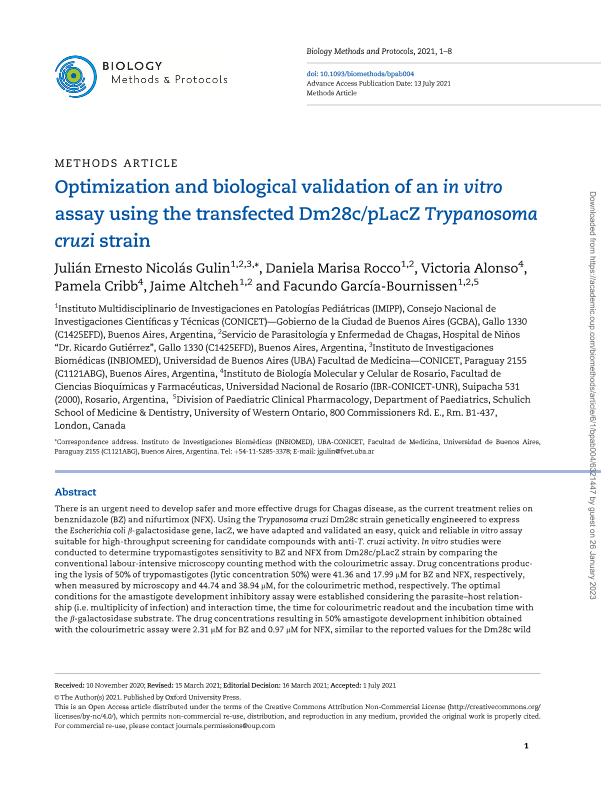Artículo
Optimization and biological validation of an in vitro assay using the transfected Dm28c/pLacZ Trypanosoma cruzi strain
Gulin, Julián Ernesto Nicolás ; Rocco, Daniela Marisa
; Rocco, Daniela Marisa ; Alonso, Victoria Lucia
; Alonso, Victoria Lucia ; Cribb, Pamela
; Cribb, Pamela ; Altcheh, Jaime Marcelo
; Altcheh, Jaime Marcelo ; García Bournissen, Facundo
; García Bournissen, Facundo
 ; Rocco, Daniela Marisa
; Rocco, Daniela Marisa ; Alonso, Victoria Lucia
; Alonso, Victoria Lucia ; Cribb, Pamela
; Cribb, Pamela ; Altcheh, Jaime Marcelo
; Altcheh, Jaime Marcelo ; García Bournissen, Facundo
; García Bournissen, Facundo
Fecha de publicación:
07/2021
Editorial:
Oxford University Press
Revista:
Biology Methods and Protocols
e-ISSN:
2396-8923
Idioma:
Inglés
Tipo de recurso:
Artículo publicado
Clasificación temática:
Resumen
There is an urgent need to develop safer and more effective drugs for Chagas disease, as the current treatment relies on benznidazole (BZ) and nifurtimox (NFX). Using the Trypanosoma cruzi Dm28c strain genetically engineered to express the Escherichia coli β-galactosidase gene, lacZ, we have adapted and validated an easy, quick and reliable in vitro assay suitable for high-throughput screening for candidate compounds with anti-T. cruzi activity. In vitro studies were conducted to determine trypomastigotes sensitivity to BZ and NFX from Dm28c/pLacZ strain by comparing the conventional labour-intensive microscopy counting method with the colourimetric assay. Drug concentrations producing the lysis of 50% of trypomastigotes (lytic concentration 50%) were 41.36 and 17.99 μM for BZ and NFX, respectively, when measured by microscopy and 44.74 and 38.94 μM, for the colourimetric method, respectively. The optimal conditions for the amastigote development inhibitory assay were established considering the parasite-host relationship (i.e. multiplicity of infection) and interaction time, the time for colourimetric readout and the incubation time with the β-galactosidase substrate. The drug concentrations resulting in 50% amastigote development inhibition obtained with the colourimetric assay were 2.31 μM for BZ and 0.97 μM for NFX, similar to the reported values for the Dm28c wild strain (2.80 and 1.5 μM, respectively). In summary, a colourimetric assay using the Dm28c/pLacZ strain of T. cruzi has been set up, obtaining biologically meaningful sensibility values with the reference compounds on both trypomastigotes and amastigotes forms. This development could be applied to high-throughput screening programmes aiming to identify compounds with anti-T. cruzi in vitro activity.
Palabras clave:
HIGH-THROUGHPUT SCREENING
,
IN VITRO DRUG SCREENING
,
TRYPANOSOMA CRUZI
Archivos asociados
Licencia
Identificadores
Colecciones
Articulos(IBR)
Articulos de INST.DE BIOLOGIA MOLECULAR Y CELULAR DE ROSARIO
Articulos de INST.DE BIOLOGIA MOLECULAR Y CELULAR DE ROSARIO
Articulos(IMIPP)
Articulos de INSTITUTO MULTIDISCIPLINARIO DE INVESTIGACIONES EN PATOLOGIAS PEDIATRICAS
Articulos de INSTITUTO MULTIDISCIPLINARIO DE INVESTIGACIONES EN PATOLOGIAS PEDIATRICAS
Articulos(INBIOMED)
Articulos de INSTITUTO DE INVESTIGACIONES BIOMEDICAS
Articulos de INSTITUTO DE INVESTIGACIONES BIOMEDICAS
Citación
Gulin, Julián Ernesto Nicolás; Rocco, Daniela Marisa; Alonso, Victoria Lucia; Cribb, Pamela; Altcheh, Jaime Marcelo; et al.; Optimization and biological validation of an in vitro assay using the transfected Dm28c/pLacZ Trypanosoma cruzi strain; Oxford University Press; Biology Methods and Protocols; 6; 1; 7-2021; 1-8
Compartir
Altmétricas



